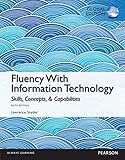| Item type | Current library | Call number | Copy number | Status | Date due | Barcode |
|---|---|---|---|---|---|---|
 Book Closed Access
Book Closed Access
|
Management Sciences Library | 004.5 SNY 1 (Browse shelf(Opens below)) | 1 | Available | PALL23090201 | |
 Book Closed Access
Book Closed Access
|
Management Sciences Library | 004.5 SNY 2 (Browse shelf(Opens below)) | 2 | Available | PALL23090202 |
Contents;
PART 1 Becoming Skilled at Computing
Chapter 1 Defining Information Technology
Terms of Endearment 3
Computation’s Greatest Hits 5
Terms of Endearment 14
Computers, Software, Algorithms 15
The Words for Ideas 19
Chapter 2 Exploring the Human-Computer Interface
Face It, It’s a Computer 25
A Few Useful Concepts 27
Perfect Reproduction 29
What We See and What We Think 34
Chapter 3 The Basics of Networking
Making the Connection 43
Comparing Communication Types 45
The Medium of the Message 48
The World Wide Web 60
File Structure 63
Chapter 4 A Hypertext Markup Language Primer
Marking Up with HTML 71
Marking Up with HTML 73
Lab Practice I 75
Structuring Documents 78
Lab Practice II 83
etc.
Chapter 5 Locating Information on the WWW
The Search for Truth 113
Web Search Fundamentals 115 Advanced Searches 121
Web Searching 126
Authoritative Information 131
Truth or Fiction? 135
Chapter 6 An Introduction to Debugging
To Err Is Human 143
Precision: The High Standards of
Computing 145
Debugging: What’s the Problem? 145
A Dialog About Debugging 147
PART 2 Algorithms and Digitizing Information
Chapter 7 Representing Information Digitally
Bits and the “Why” of Bytes 177
Digitizing Discrete Information 179
Information Representation 181
Binary and Hex 185
Digitizing Numbers in Binary 187
Digitizing Text 190
Chapter 8 Representing Multimedia Digitally
Light, Sound, Magic 203
Digitizing Color 205
Computing on Representations 212
Digitizing Sound 218
Digital Images and Video 221
Optical Character Recognition 226
Multimedia Challenges 228
Bits Are It 229
Chapter 9 Principles of Computer Operations
Following Instructions 235
There’s an App for That 237
Software Isn’t So Hard 238
Instruction Execution Engine 242
The Program Counter:
The PC’s PC 248
Instruction Execution 249
Translation 254
Chapter 10 Algorithmic Thinking
What’s the Plan? 269
Algorithms 271
Algorithms–A Basic Concept 277
A Closer Look 278
Doing the Right Thing 282
PART 3 Data and Information
Chapter 11 Social Implications of IT
Computers in Polite Society 295
The Power of the Crowd 297
Out on Good Behavior 299
Expect the Unexpected 303
Creating Good Passwords 304
Spam 309
Scams 310
Chapter 12 Privacy and Digital Security
Shhh, It’s a Secret 327
Privacy and Technology 329
A Privacy Definition 330
Enjoying the Benefits of Privacy 331
Fair Information Practices 332
Is There No Privacy? 333
Tracking 336
Cookies 340
Chapter 13 The Basics of Spreadsheets
Fill-in-the-Blank Computing 363
Arranging Information 365
Computing with Spreadsheets 369
Daily Spreadsheets 378
Importing Data 384
Chapter 14 Advanced Spreadsheets for Planning
“What If” Thinking Helps 395
Designing a Spreadsheet 397
Conditional Formatting 400
Conditional Formulas 403
Naming: Symbolic Reference 406
“What If ” Analysis 409
Analyzing Data Using Filtering 415
Chapter 15 Introduction to Database Concepts
A Table with a View 423
Differences Between Tables and
Databases 425
XML: A Language for Metadata
Tags 426
Tables and Entities 432
The Science of Tables 435
SQL: The Language of Databases 446
Structure of a Database 449
Chapter 16 A Case Study in Database Organization
The iDiary Database 455
Thinking About a Personal
Database 457
A Preliminary Exercise 458
The iDiary Database 468
Using the iDiary Daily 478
PART 4 Problem Solving
Chapter 17 Fundamental Concepts Expressed in JavaScript
Get with the Program 489
Overview: Programming
Concepts 491
Names, Values, and Variables 492
Three Basic Data Types of
JavaScript 496
The Assignment Statement 499
Chapter 18 A JavaScript Program
The Bean Counter 521
Preliminaries 523
Background for the UI 524
Creating the Graphical User
Interface 527
Event-Based Programming 530
Critiquing the Bean Counter 534
Chapter 19 Programming Functions
Thinking Big 543
Anatomy of a Function 545
Forms and Functions 548
Writing Functions, Using
Functions 550
Customizing Pages 556
Making a Web-Based Phone App 559
Social Functions 564
Chapter 20 Iteration Principles
Once Is Not Enough 575
Iteration: Play It Again, Sam 577
JavaScript Rules for for Loops 579
Experiments with Flipping Coins 582
Indexing 587
Arrays 588
It’s Magic 590
Chapter 21 A Case Study in Algorithmic Problem Solving
The Smooth Motion Application 605
The Smooth Motion Application 607 Planning Smooth Motion 608
Build the Basic Web Page UI 611
Animate the Grid 612
The Best Laid Plans . . . 616
Build Controls 617
Sense the Keys 618
Chapter 22 Limits to Computation
Computers Can Do Almost {Q Everything, Q Nothing} 629
Can Computers Think? 631
Acting Intelligently? 633
Watson 638
Acting Creatively? 642
The Universality Principle 645
More Work, Slower Speed 648
Are “Best” Algorithms All Fast? 649
Chapter 23 A Fluency Summary
Click to Close 655
Two Big Computing Ideas 657
Fluency: Less Is More 658
Lifelong IT Learning 660
Shifting for Yourself 662
Try It Solutions 662
Index : p. 749-768.


There are no comments on this title.